The MSI GE75 Raider Laptop Review: Core i9 and RTX 2080 Performance
by Brett Howse on July 12, 2019 8:00 AM ESTBattery Life
Battery life on gaming laptops tends to be an afterthought, although with more power efficient processors, and technologies like NVIDIA’s Optimus which allows the dGPU to be disabled, some gaming laptops can squeak out reasonable runtimes.
MSI has settled on a reasonably sized 65 Wh battery for the GE75 Raider, which is pretty typical for a laptop of this class. Some gaming laptops, such as the Acer Predator Triton 500, offer a much larger battery, which makes sense since that laptop is thinner and lighter and therefore more likely to not be used on a desk, but most gaming laptops offer smaller batteries since they spend most of their life plugged into the wall.
To see how the GE75 Raider performs, it was run through our standard laptop battery life suite with the display set to 200 nits brightness.
Light Battery
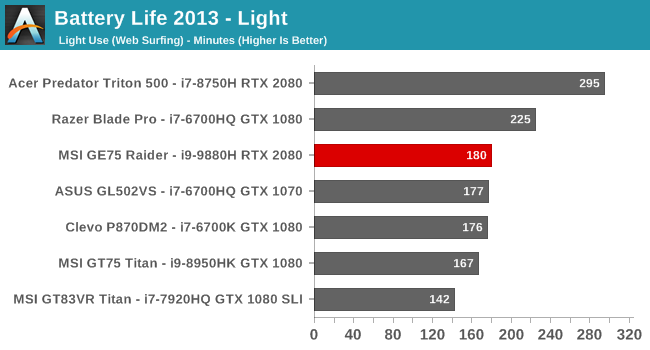
Despite offering Optimus, the smaller battery capacity limits the GE75 Raider significantly. A 17.3-inch display is still a lot of display to light up, so battery runtime is middling at best.
Web Battery
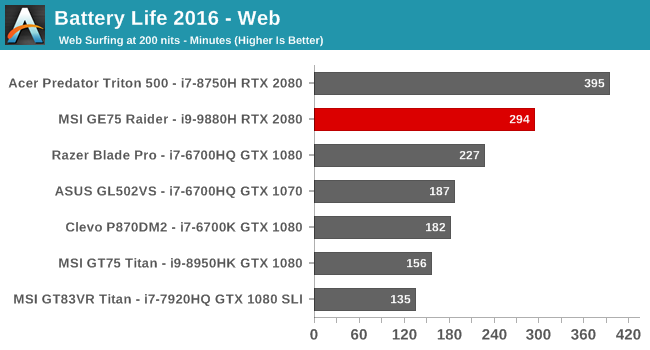
Our more demanding web rundown generally offers lower runtime on laptops where the CPU can be one of the main power draws, but on gaming laptops the base power draw generally masks this, and as we’ve seen a few other times the more demanding test results in higher battery life than the less demanding test. The GE75 does well here, but certainly not to the point where you’d consider it “all day” battery life by any means.
Movie Playback
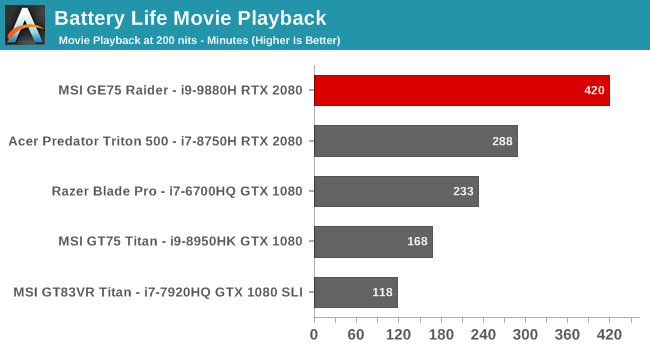
Video playback is a unique scenario since the video decode is done on fixed function hardware in the CPU, and lets the rest of the device more or less power down to its lowest settings. The GE75 Raider lasted a surprising seven hours in this test, which is impressive considering its mid-sized battery.
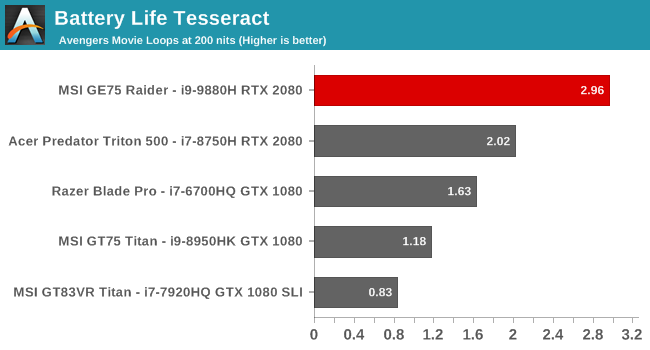
Our Tesseract score divides the movie playback time by the length of a long movie, to give you a feel for how many movies you could watch in a row. Coming in at right about three complete movies, the GE75 Raider does well, and punches above its class.
Normalized Results
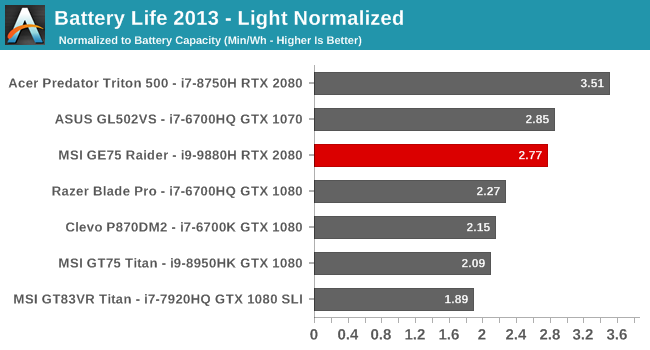
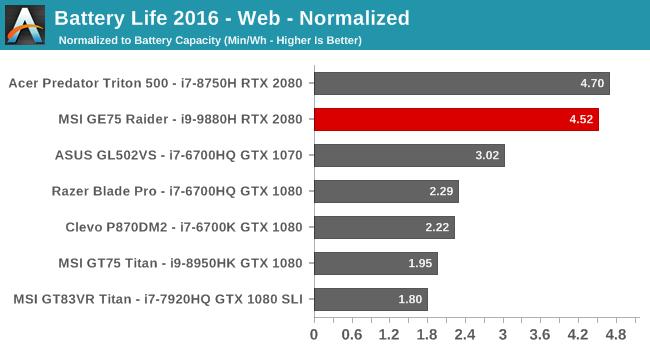
Next we remove the battery size from the equation to give an indication of how efficient each laptop is. None of these laptops can be confused with an Ultrabook here, but the MSI GE75 is reasonable efficient in terms of battery power draw considering the components inside and the large display.
Charge Time
MSI ships the GE75 Raider with up to a 280-Watt AC Adapter, offering plenty of headroom for any scenario. Since the power output is so high, there’s of course no chance for USB-C charging because of that port’s maximum power limit of just 100 Watts, so it’ll be some time before we see any sort of standardized charging port for gaming laptops. MSI has gone with a typical barrel connector, which is quite sturdy thanks to the size.
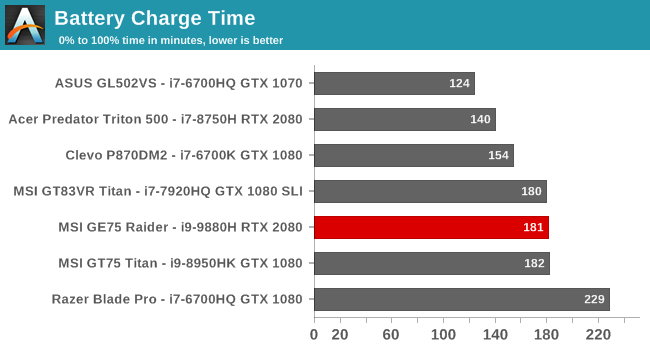
Charge time isn’t anything amazing though, even though the AC adapter is massive and the battery size is small. Likely in an effort to preserve the life of the battery the charge rate is quite limited. Since it’s mostly designed to be plugged in regardless, the three hour charge rate is in-line with expectations.
MSI also interestingly adds in some additional choices in terms of charging. You can adjust the battery charge settings in the Dragon Center Software which allows you to choose how to keep the battery level. If you are someone who does use the laptop on the go from time to time, you can set it to mobility, or you can set the battery to be charged to a lower level which should prolong the life. It’s a nice option for a system where outright mobility is certainly a secondary consideration.
One thing to note though on the charging system, at least in the review unit, is that there is some noticeable charging whine from inside the laptop, especially when the system is fully charged. It’s not overtly loud and disruptive, but it is there and needs to be pointed out.











30 Comments
View All Comments
MattL - Monday, July 15, 2019 - link
As it turns out I just upgraded from an OLED 1440p Alienware 13" laptop to this exact ge75 i9 9880h 2080 laptop.I was concerned about going from 13" 1440p (on that beautiful OLED screen) to 17" and 1080p.
I can say absolutely it's not a problem. 17" at 1080p is perfectly fine. Basically it's almost the same pixel density as my 34" Ultra Wide 3440x1440p (120hz IPS) display which is pretty high res itself (the max you'd want for gaming).
4k gaming would be horrible.... you'd get no FPS. getting closer to 144hz (at least 80-100+ FPS) is far more important.
On the best games even this top notch 2080 can struggle to get 100 fps at 1080p in some cases if you have your settings set high....
1080p is exactly the appropriate resolution for a modern gaming laptop.
Zanor - Wednesday, July 17, 2019 - link
It's a laptop very focused on gaming. Gamers don't want 60hz.DanNeely - Friday, July 12, 2019 - link
"Second, this keyboard has a slightly strange layout, with the Windows Key being on the right side of the keyboard along with a duplicate backslash key."Half of this is apparently due to MSI using an international mechanical layout with an extra keycap rather than a different piece of hardware for the US model. The second half which has always baffled me is that they put a pipe on the extra key instead of a right click key; which although increasingly rare would map back towards the original 104 key layout.
cgeorgescu - Saturday, July 13, 2019 - link
FN and Win keys can be swapped (physically and in BIOS), then the somehow strangely-placed keys can be re-mapped with that Steelseries software.On mine (an older MSI GS), I have Del instead of Pause and AltGR instead of that second |\ right of the spacebar.
Now unrelated to keys: all MSI laptops can be bought in wildly customised configuration, there are tons of small shops (online) who sell these with any combination of SSDs, memory, etc.
eva02langley - Friday, July 12, 2019 - link
280W power supply!!!!?How much does that thing cost by its own, 150$!!!???
Anyway, I am waiting for my Zen 2 APU laptop with Navi cores.
ads295 - Friday, July 12, 2019 - link
Agreed. I think it may be possible to have 1080p eSports gaming for 3-4 hours on battery with an APU.DanNeely - Friday, July 12, 2019 - link
probably. I couldn't find MSIs model as a replacement, but the equivalent ASUS model is $149 direct.Vitor - Friday, July 12, 2019 - link
Holy sheet, those display numbers are incredible. Basically a gaming notebook that can be used for professional edition.Duncan Macdonald - Friday, July 12, 2019 - link
Given the position of the air intakes - this is not suitable for laptop use. If used on a lap much of the airflow will be blocked and there will be nasty temperatures near some sensitive bits. This device is a lightweight Desktop Replacement - not a laptop.In my opinion if you want a portable gaming system (especially with a high end GPU like the 2080) then you should get a system with good cooling which implies a thicker chassis with better airflow, larger heatsinks and fans and a higher weight.
Two things that "laptop" reviews should do are show the bottom temperatures after an hour of heavy use and also see if the cooling system can stand up to being used on a lap without cooking the laptop or the user.
nevcairiel - Saturday, July 13, 2019 - link
Is it really that common to actually use a laptop in your lap directly? That has always been exceedingly uncomfortable for me, no matter if gaming or working. Would always grab a table or perhaps one of those laptop lap stands that gives it more height and a flat surface to keep it's vents free